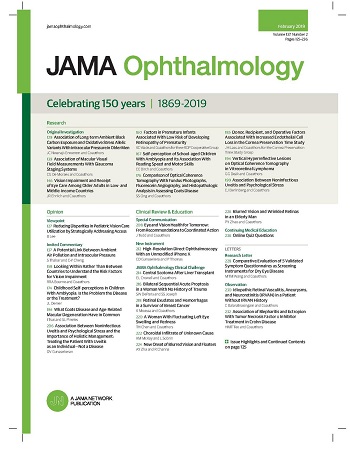Diversified Segmental Defocus Optimization Lenses With and Without Atropine for Myopia Prevention: A Randomized Clinical Trial.
IF 9.2
1区 医学
Q1 OPHTHALMOLOGY
引用次数: 0
Abstract
Importance With growing myopia prevalence worldwide, effective strategies to prevent early-onset myopia are needed. Objective To evaluate the efficacy of diversified segmental defocus optimization (DSDO) spectacle lenses with or without 0.01% atropine for myopia prevention. Design, Setting, and Participants This was 1-year randomized placebo-controlled double-masked clinical trial conducted in the Department of Ophthalmology at Peking University People's Hospital from November 2023 to December 2024. Children aged 5 to 12 years with spherical equivalent refraction (SER) of 0.00 to 1.00 diopters (D) after cycloplegia were included, excluding those with ocular diseases, systemic diseases, or previous use of optical or pharmaceutical myopia control methods. Interventions Participants were randomly assigned in a 1:1:1 ratio to receive DSDO spectacles with placebo eye drops (DSDO group), DSDO spectacles with 0.01% atropine eye drops (DSDOA group), or single-vision spectacles with placebo eye drops (control group). Main Outcomes and Measures The primary outcomes were the cumulative incidence rate of myopia (defined as SER ≤-0.50 D) and the percentage of participants with fast myopic shift (defined as a spherical equivalent myopic shift ≥0.50 D) over 1 year. Secondary outcomes included changes in SER, axial length, and subfoveal choroidal thickness. Results Of the 450 children initially randomized (DSDO group: mean [SD] age, 7.05 [0.12] years; 77 [51.3%] male; DSDOA group: mean [SD] age, 7.02 [0.14] years; 73 [48.7%] male; control group: mean [SD] age, 7.01 [0.11] years; 78 [52.0%] male), 370 (82.2%) completed the study, including 121 in the DSDO group, 125 in the DSDOA group, and 124 in the control group. The 1-year cumulative incidence rates of myopia in the DSDO, DSDOA, and control groups were 5.8% (7/121), 4.8% (6/125), and 15.3% (19/124), respectively, and the percentages of participants with fast myopic shift after 1 year were 15.7% (19/121), 9.6% (12/125), and 42.7% (53/124). Both DSDO and DSDOA groups showed significantly lower 1-year cumulative myopia incidence (DSDO: difference, 9.5%; 95% CI, 1.9-17.5; P = .02; DSDOA: difference, 10.5%; 95% CI, 3.3-18.4; P = .006) and the percentage of patients with fast myopic shift (DSDO: difference, 27.0%; 95% CI, 16.1-37.3; P < .001; DSDOA: difference, 33.1%; 95% CI, 23.1-42.8; P < .001) vs control. No significant differences were observed between DSDO and DSDOA groups. Conclusions and Relevance These data suggest that daily use of DSDO spectacles delays the onset of myopia among children without myopia, supporting DSDO spectacles without atropine as an alternative preventive method for children without myopia if supported with longer follow-up and replication by others. Trial Registration Chinese Clinical Trial Registry: ChiCTR2300077307.使用阿托品和不使用阿托品预防近视的多样化分段离焦优化镜片:一项随机临床试验。
随着全球近视发病率的上升,需要有效的策略来预防早发性近视。目的评价含0.01%阿托品和不含0.01%阿托品的多元节段离焦优化(DSDO)镜片预防近视的效果。设计、环境和参与者本研究于2023年11月至2024年12月在北京大学人民医院眼科进行,为期1年的随机安慰剂对照双盲临床试验。研究对象为5 - 12岁,睫状体麻痹后球体等效屈光度(SER)为0.00 - 1.00屈光度(D)的儿童,不包括眼部疾病、全身性疾病或既往使用光学或药物近视控制方法的儿童。干预措施:参与者按1:1:1的比例随机分配,接受DSDO眼镜加安慰剂滴眼液(DSDO组)、DSDO眼镜加0.01%阿托品滴眼液(DSDOA组)或单视力眼镜加安慰剂滴眼液(对照组)。主要结果和测量主要结果是1年内近视的累积发病率(定义为SER≤-0.50 D)和快速近视移位(定义为球面等效近视移位≥0.50 D)的参与者百分比。次要结果包括SER、轴向长度和中央凹下脉络膜厚度的变化。结果初始随机分组450例患儿(DSDO组):平均[SD]年龄,7.05[0.12]岁;男性77例[51.3%];DSDOA组:平均[SD]年龄,7.02[0.14]岁;男性73例[48.7%];对照组:平均[SD]年龄,7.01[0.11]岁;78例(52.0%)男性,370例(82.2%)完成研究,其中DSDO组121例,DSDOA组125例,对照组124例。DSDO组、DSDOA组和对照组的1年累计近视发病率分别为5.8%(7/121)、4.8%(6/125)和15.3%(19/124),1年后快速近视转移的比例分别为15.7%(19/121)、9.6%(12/125)和42.7%(53/124)。DSDO组和DSDOA组1年累计近视发生率均显著降低(DSDO:差异为9.5%;95% ci, 1.9-17.5;p = .02;DSDOA:差值10.5%;95% ci, 3.3-18.4;P = 0.006),快速近视移位患者比例(差值:27.0%;95% ci, 16.1-37.3;p < .001;DSDOA:差33.1%;95% ci, 23.1-42.8;P < 0.001)。DSDO组与DSDOA组间无显著差异。结论和相关性这些数据表明,日常使用DSDO眼镜可以延迟非近视儿童的近视发生,支持不使用阿托品的DSDO眼镜作为非近视儿童的一种替代预防方法,如果有更长的随访和其他人的复制支持的话。中国临床试验注册中心:ChiCTR2300077307。
本文章由计算机程序翻译,如有差异,请以英文原文为准。
求助全文
约1分钟内获得全文
求助全文
来源期刊

JAMA ophthalmology
OPHTHALMOLOGY-
CiteScore
13.20
自引率
3.70%
发文量
340
期刊介绍:
JAMA Ophthalmology, with a rich history of continuous publication since 1869, stands as a distinguished international, peer-reviewed journal dedicated to ophthalmology and visual science. In 2019, the journal proudly commemorated 150 years of uninterrupted service to the field. As a member of the esteemed JAMA Network, a consortium renowned for its peer-reviewed general medical and specialty publications, JAMA Ophthalmology upholds the highest standards of excellence in disseminating cutting-edge research and insights. Join us in celebrating our legacy and advancing the frontiers of ophthalmology and visual science.
 求助内容:
求助内容: 应助结果提醒方式:
应助结果提醒方式:


